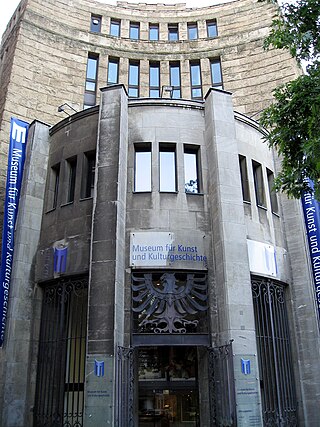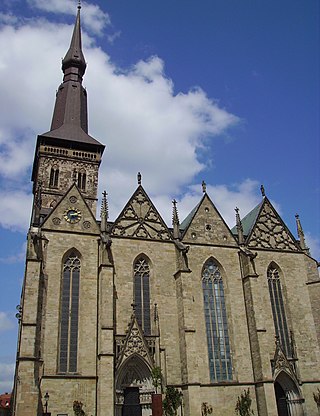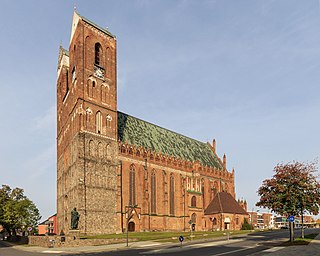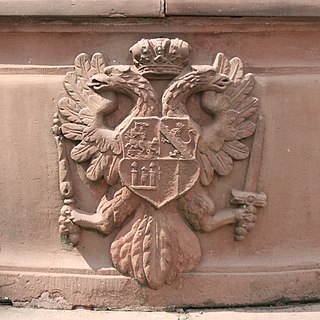
Dortmund is the third-largest city in North Rhine-Westphalia, after Cologne and Düsseldorf, and the ninth-largest city in Germany. With a population of 612,065 inhabitants, it is the largest city of the Ruhr as well as the largest city of Westphalia. It lies on the Emscher and Ruhr rivers in the Rhine-Ruhr Metropolitan Region, the second biggest metropolitan region by GDP in the European Union, and is considered the administrative, commercial, and cultural centre of the eastern Ruhr. Dortmund is the second-largest city in the Low German dialect area, after Hamburg.

St. Mary's Church, or formally the Basilica of the Assumption of the Blessed Virgin Mary, is a Brick Gothic Catholic church located in central Gdańsk, Poland. With its volume between 185,000 m3 and 190,000 m3 it is currently one of the two or three largest brick churches in the world. Only San Petronio Basilica in Bologna, comprising 258,000 m3 is larger, Munich Frauenkirche and Ulm Minster also comprise 185,000 to 190,000 m3.

Warendorf is a town in North Rhine-Westphalia, Germany, and capital of Warendorf District.

The Lübeck Marienkirche is a medieval basilica in the city centre of Lübeck, Germany. Built between 1265 and 1352, the church is located on the highest point of Lübeck's old town island within the Hanseatic merchants' quarter, which extends uphill from the warehouses on the River Trave to the church. As the main parish church of the citizens and the city council of Lübeck, it was built close to the town hall and the market.

St. Mary's Church, known in German as the Marienkirche or St.-Marien-Kirche, is a church in Berlin, Germany. It is located on Karl-Liebknecht-Straße in central Berlin, near Alexanderplatz. The exact age of the original church site and structure is not precisely known, but it was mentioned as the site of the alleged theft by Jews of the wafers in an act of Host Desecration in 1243. As a result of these charges, a number of Jews were burnt at the stake at a place later called Judenberg. It is also mentioned in German chronicles in 1292. It is presumed to date from earlier in the 13th century.

Conrad von Soest, also Konrad in modern texts, or in Middle High German Conrad van Sost or "von Soyst", was the most significant Westphalian artist and painted in the so-called soft style of International Gothic. He played a leading role in the introduction of this International Courtly Style to Northern Germany around 1390 and influenced German and Northern European painting into the late 15th century. He was the master of a thriving workshop and was accepted into the social circle of the cosmopolitan patrician elite of Dortmund. Dortmund was then a leading and very prosperous member of the influential Hanseatic League.

The Master of the Berswordt Altar was a German painter, active in the area around Dortmund during the 14th and 15th centuries. A number of works around Westphalia, including one in Bielefeld, are attributed to him. His altar is in the Marienkirche, Dortmund.

Cappenberg Castle is a former Premonstratensian monastery, Cappenberg Abbey in Cappenberg, a part of Selm, North Rhine-Westphalia in Germany. It stands on an elevation, the Cappenberg, near Lünen and Werne, and is a vantage point offering views over the eastern Ruhrgebiet.

The Museum für Kunst und Kulturgeschichte or MKK is a municipal museum in Dortmund, Germany. It is currently located in an Art Deco building which was formerly the Dortmund Savings Bank.

Altes Stadthaus in Dortmund, North Rhine-Westphalia, Germany, is an office block which was built in 1899, and was designed by "master builder" Friedrich Kullrich. It was built in the Renaissance Revival architecture (Neo-Renaissance) style. After the office block was severely damaged in World War II, it was rebuilt in a simplified form.

St. Peter is a Romanesque church in Syburg, now a suburb of Dortmund, Germany. It is the active Protestant parish church of Syburg, officially named "Ev. Kirche St. Peter zu Dortmund-Syburg". It serves as a concert venue for the bimonthly Syburger Sonntagsmusiken.

St. Marien is a Lutheran parish and market church in Osnabrück, Germany. It is one of the most artistically and historically significant buildings in the North German city. A previous Romanesque church was mentioned in records as early as 1177. However, the history of the church's construction began some time before it was first mentioned in writing. Archaeological traces suggest the existence of a predecessor building in the 10th century. Construction of the Gothic hall church which exists today started in the 13th century and was completed between 1430 and 1440.

The following is a timeline of the history of the city of Dortmund, Germany.

The County of Moers was a historical princely territory on the left bank of the Lower Rhine that included the towns of Moers and Krefeld as well as the surrounding villages and regions.

St. Moritz, also St. Mauritius, is a church in Halle (Saale), Saxony-Anhalt, Germany, dedicated to St. Maurice. The late-Gothic hall church was built as an Augustine Stiftskirche from 1388. It features late-Gothic stone sculptures and a notable organ from 1925.

Propsteikirche is the common name of a church in Dortmund, North Rhine-Westphalia, Germany, the only Catholic church in the city centre. The full name is Propsteikirche St. Johannes Baptist Dortmund. It was built from 1331 as the abbey church of a Dominican monastery. Consecrated in 1458, it features a late-Gothic high altar by Derick Baegert which shows the oldest depiction of Dortmund.

The Marienkirche in Prenzlau, Brandenburg, Germany, is the main Protestant parish church in the town, and is one of the most ornate churches of the Brick Gothic style in northern Germany. The church is a listed building.
Rolf Fritz was a German art historian. His research focused on German art from the Middle Ages to the 19th century, especially on the art and cultural history of Westphalia, as well as on various genres of arts and crafts.

The Marienaltar by Conrad von Soest is an altar retable in the Marienkirche in Dortmund from around 1420. It is considered a masterpiece of the late Gothic period and is a good example of the courtly style. Executed as a triptych, the retable is the painter's latest known work, completed shortly before his death. It is the main altar of the Dortmund church.

The Burgraviate of Friedberg was a territory within the Holy Roman Empire. It emerged during the Late Middle Ages from the Burgmannschaft of Reichsburg Friedberg in Hesse. Notably, the Burgraviate featured a cooperative constitutional structure and was endowed with manorial privileges by the Emperor, which were reaffirmed multiple times until its dissolution in 1806. The Burgraviate established its territory, which, in addition to overseeing the neighboring Reichsstadt Friedberg and the Freigericht Kaichen, included a narrow strip of land in the southern Wetterau. Consequently, Friedberg Castle can be regarded as the sole reichsständische castle since its inclusion in the Reichsmatrikel in 1431. According to its self-perception, the Kayserliche und des heiligen Reichs-Burg Friedberg, as it was called, was a prominent institution of the Imperial Knighthood and directly subordinate to the king or emperor.






















